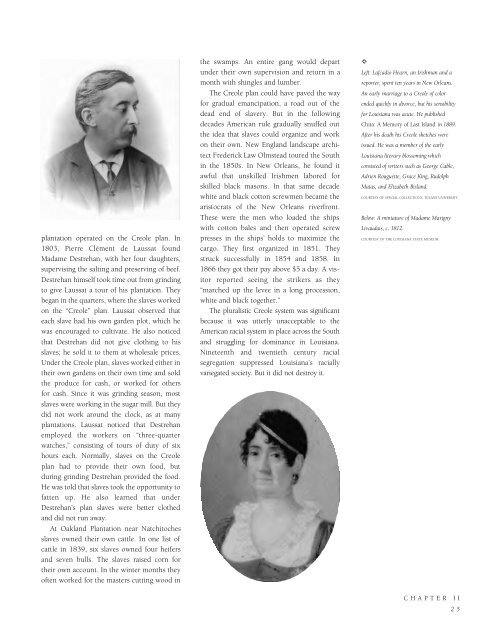Historic Louisiana
An illustrated history of Louisiana, paired with the histories of companies, families and organizations that make the state great.
An illustrated history of Louisiana, paired with the histories of companies, families and organizations that make the state great.
You also want an ePaper? Increase the reach of your titles
YUMPU automatically turns print PDFs into web optimized ePapers that Google loves.
plantation operated on the Creole plan. In<br />
1803, Pierre Clément de Laussat found<br />
Madame Destrehan, with her four daughters,<br />
supervising the salting and preserving of beef.<br />
Destrehan himself took time out from grinding<br />
to give Laussat a tour of his plantation. They<br />
began in the quarters, where the slaves worked<br />
on the “Creole” plan. Laussat observed that<br />
each slave had his own garden plot, which he<br />
was encouraged to cultivate. He also noticed<br />
that Destrehan did not give clothing to his<br />
slaves; he sold it to them at wholesale prices.<br />
Under the Creole plan, slaves worked either in<br />
their own gardens on their own time and sold<br />
the produce for cash, or worked for others<br />
for cash. Since it was grinding season, most<br />
slaves were working in the sugar mill. But they<br />
did not work around the clock, as at many<br />
plantations. Laussat noticed that Destrehan<br />
employed the workers on “three-quarter<br />
watches,” consisting of tours of duty of six<br />
hours each. Normally, slaves on the Creole<br />
plan had to provide their own food, but<br />
during grinding Destrehan provided the food.<br />
He was told that slaves took the opportunity to<br />
fatten up. He also learned that under<br />
Destrehan’s plan slaves were better clothed<br />
and did not run away.<br />
At Oakland Plantation near Natchitoches<br />
slaves owned their own cattle. In one list of<br />
cattle in 1839, six slaves owned four heifers<br />
and seven bulls. The slaves raised corn for<br />
their own account. In the winter months they<br />
often worked for the masters cutting wood in<br />
the swamps. An entire gang would depart<br />
under their own supervision and return in a<br />
month with shingles and lumber.<br />
The Creole plan could have paved the way<br />
for gradual emancipation, a road out of the<br />
dead end of slavery. But in the following<br />
decades American rule gradually snuffed out<br />
the idea that slaves could organize and work<br />
on their own. New England landscape architect<br />
Frederick Law Olmstead toured the South<br />
in the 1850s. In New Orleans, he found it<br />
awful that unskilled Irishmen labored for<br />
skilled black masons. In that same decade<br />
white and black cotton screwmen became the<br />
aristocrats of the New Orleans riverfront.<br />
These were the men who loaded the ships<br />
with cotton bales and then operated screw<br />
presses in the ships’ holds to maximize the<br />
cargo. They first organized in 1851. They<br />
struck successfully in 1854 and 1858. In<br />
1866 they got their pay above $5 a day. A visitor<br />
reported seeing the strikers as they<br />
“marched up the levee in a long procession,<br />
white and black together.”<br />
The pluralistic Creole system was significant<br />
because it was utterly unacceptable to the<br />
American racial system in place across the South<br />
and struggling for dominance in <strong>Louisiana</strong>.<br />
Nineteenth and twentieth century racial<br />
segregation suppressed <strong>Louisiana</strong>’s racially<br />
variegated society. But it did not destroy it.<br />
✧<br />
Left: Lafcadio Hearn, an Irishman and a<br />
reporter, spent ten years in New Orleans.<br />
An early marriage to a Creole of color<br />
ended quickly in divorce, but his sensibility<br />
for <strong>Louisiana</strong> was acute. He published<br />
Chita: A Memory of Last Island in 1889.<br />
After his death his Creole sketches were<br />
issued. He was a member of the early<br />
<strong>Louisiana</strong> literary blossoming which<br />
consisted of writers such as George Cable,<br />
Adrien Rouguette, Grace King, Rudolph<br />
Matas, and Elizabeth Bisland.<br />
COURTESY OF SPECIAL COLLECTIONS, TULANE UNIVERSITY.<br />
Below: A miniature of Madame Marigny<br />
Livaudais, c. 1812.<br />
COURTESY OF THE LOUISIANA STATE MUSEUM.<br />
CHAPTER II<br />
25
















